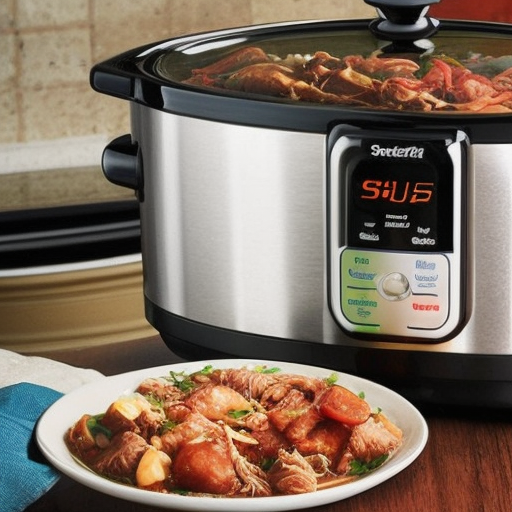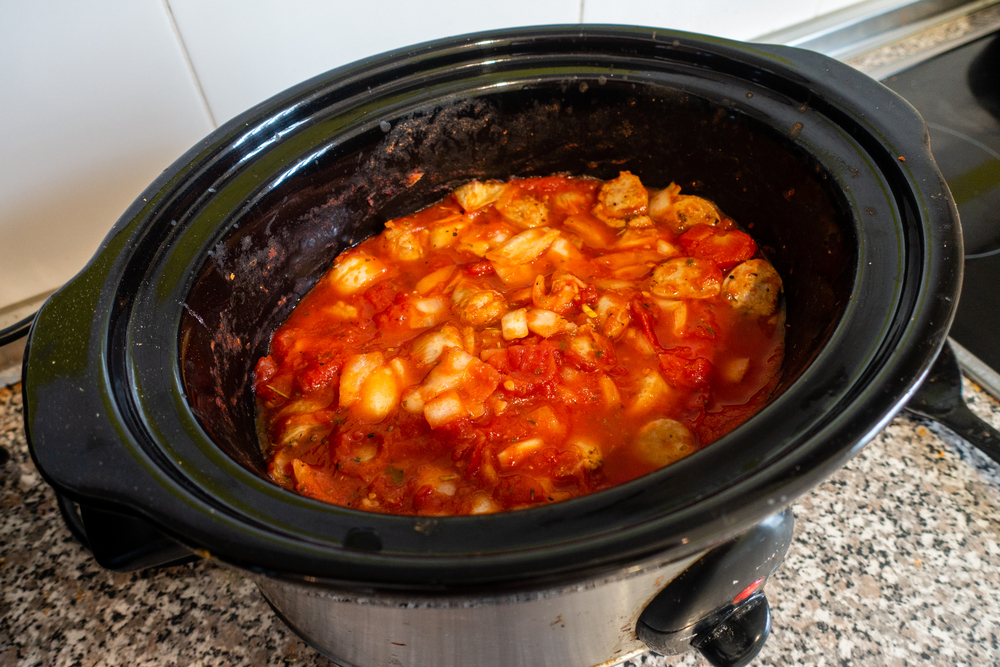Last Updated on February 6, 2023
Are you curious about what temperature does a slow cooker cook at? You may be surprised to find out that it’s not as high as you’d think. Slow cooking is becoming increasingly popular due to its low-temperature approach, which yields more flavorful dishes and can also reduce the risk of foodborne illnesses. In this blog post, we’ll explain exactly how hot your slow cooker should get when in use and provide some helpful safety tips for using one correctly. We’ll even share troubleshooting advice for common problems so that you can enjoy perfectly cooked meals every time. So let’s dive into the details.
Table of Contents:
- Slow Cooker Temperature Basics
- Benefits of Low-Temperature Cooking
- Troubleshooting Common Slow Cooker Problems
- FAQs in Relation to What Temperature Does a Slow Cooker Cook at
- Conclusion
Slow Cooker Temperature Basics
Slow cookers are a great way to make delicious, home-cooked meals with minimal effort. But before you get started, it’s important to understand the basics of slow cooker temperature and how it affects your cooking results.
The main difference between slow cookers and traditional ovens is that they use low temperatures over long periods of time to gently heat food. This allows flavours to develop more fully while keeping ingredients tender and juicy. Slow cookers typically have two settings: high (around 300°F) or low (around 200°F). The exact temperature varies depending on the model, but most will range from 190°F – 300°F.
High temperatures are best for dishes that require quick cooking times such as stews, soups, chilli and other one-pot meals. High temperatures also work well for meats like chicken breasts or pork chops which can dry out if cooked too slowly at lower temperatures. Low temperatures are better suited for tougher cuts of meat such as brisket or chuck roast which need longer cooking times in order to become tender enough to eat without falling apart when served. Low settings also work well for braising vegetables like carrots or potatoes which can be cooked until they’re soft but still retain their shape and texture after being cooked in liquid over a long period of time at low heat levels.

When using a slow cooker, it is important not to fill the pot more than two-thirds full so that there is enough room for steam circulation during the cooking process; otherwise your food may not cook evenly or completely due to lack of airflow around the ingredients inside the pot. It is also important not to lift the lid off during cooking unless absolutely necessary since this will release some of the built-up steam pressure inside causing uneven heating throughout your dish – resulting in an inconsistent finished product.
Cooking with a slow cooker can provide delicious meals in a fraction of the time, but understanding how temperature works is key to achieving the best results. Knowing the benefits of low-temperature cooking will help you make even more flavorful dishes.
Benefits of Low-Temperature Cooking
Cooking at low temperatures has become increasingly popular in recent years, and for good reason. Low-temperature cooking offers a number of benefits that can make it easier to prepare delicious meals without sacrificing nutrition or flavour.
One of the biggest advantages of low-temperature cooking is that it helps retain more nutrients and flavours in food than higher temperature methods like boiling or frying. This means you get all the vitamins, minerals, and other healthful compounds from your ingredients while still enjoying great taste.
Low-temperature cooking also eliminates much of the guesswork associated with preparing a meal since there’s no need to worry about overcooking or burning food due to high heat levels. You can just set it and forget it until dinner time rolls around. Additionally, because foods are cooked slowly at lower temperatures they tend not dry out as quickly so dishes stay moist throughout their entire cooking process which makes them extra tasty when served up at dinnertime.
Finally, using a slow cooker helps reduce energy costs by using less electricity than traditional ovens do; this means fewer bills for households trying to save money each month. And if you’re looking for an eco-friendly way of preparing meals then this method definitely fits the bill since no additional fuel sources (like gas) are required either, making it an ideal choice for those wanting greener options in their kitchen routine too.
Troubleshooting Common Slow Cooker Problems
However, like any kitchen appliance, they can sometimes run into problems. Here are some of the most common slow cooker issues and how to troubleshoot them:
Uneven Heating:
If your food is not cooking evenly in your slow cooker, it could be due to an uneven heating element or incorrect temperature settings. To test if this is the issue, place a thermometer inside the pot and check that it reads at least 165°F (74°C). If it does not reach this temperature then you may need to adjust the heat setting on your slow cooker or replace its heating element.
Food Sticking To The Bottom Of The Pot:
This problem often occurs when food has been cooked for too long or on too high a heat setting. To prevent sticking, use less liquid in recipes and reduce cooking time by about 10 minutes per hour of recommended cooking time stated in recipes. You should also stir ingredients every few hours during cooking as this will help prevent sticking and burning on the bottom of the pot.
Burning On The Sides Of The Pot:
If you find that food is burning around the sides of your slow cooker’s pot then you may need to reduce both liquid quantity and temperature settings in order to prevent further burning from occurring. It’s also important that you keep an eye on what’s happening inside your slow cooker while it cooks so that you can adjust temperatures accordingly if needed throughout cooking time.
Overcooking Food:

To avoid overcooking food in a slow cooker, always start with fresh ingredients as frozen foods take longer to cook than those which have been freshly prepared before adding them into the pot. Additionally, ensure all ingredients are cut into small pieces so they will cook more quickly within shorter periods of time set for each recipe being made in your slow cooker. Lastly, remember that some vegetables such as potatoes require longer cooking times than others, so add these towards the end of total recommended cooking times given for each recipe being made with your appliance.
FAQs in Relation to What Temperature Does a Slow Cooker Cook at
What temperature does a slow cooker cook on high?
A slow cooker typically cooks on high at around 200°F (93°C). This temperature is ideal for cooking most dishes, as it allows food to cook slowly and evenly. It also helps to keep the moisture in the food, resulting in tender and flavorful meals. However, some recipes may require a higher or lower temperature setting; always check your recipe instructions before starting your slow cooker.
Do you cook slow cooker on high or low?
Cooking with a slow cooker can be done on either high or low settings, depending on the recipe and desired outcome. High heat will cook food faster but may result in tougher textures, while low heat takes longer to cook but produces tender results. For best results, always follow the instructions provided with your slow cooker recipe. Experimentation is also encouraged – try different cooking times and temperatures to find what works best for you.
Conclusion
With the right temperature setting, you can create amazing dishes that will impress your family and friends. By understanding what temperature does a slow cooker cook at and following some basic safety tips, you can ensure that your slow cooker experience is enjoyable and successful every time. So go ahead, and experiment with different recipes in your slow cooker – just remember to keep an eye on the temperature.
Paul is the type of person who never met a problem he couldn’t fix. He can always be found tinkering with something in his house, even if it isn’t broken! His tips and tricks are often shared on our site. He’s the one you call when something breaks because he has been known to improvise fixes for everything from leaky faucets to malfunctioning dryers.

